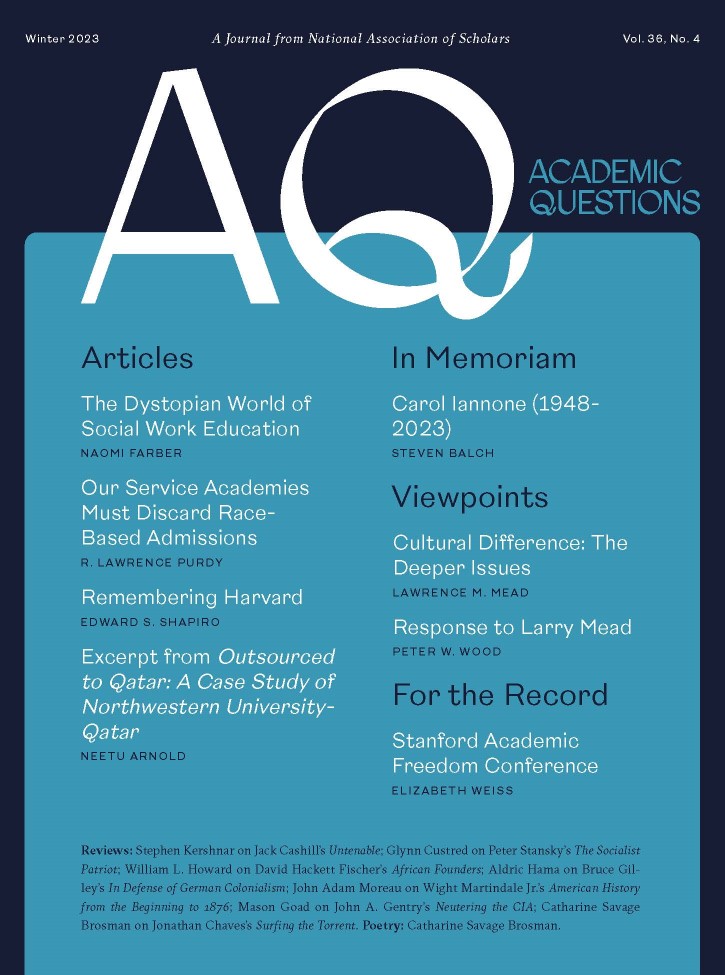Neutering the CIA: Why US Intelligence Versus Trump Has Long-Term Consequences, John A. Gentry, Armin Lear Press, 2023, pp. 528, $37.98 hardcover.
All of my instructors and education reinforced the idea that the ethos of an intelligence officer is summarized in two simple rules: First, tell the truth, no matter the consequences, because failure to properly inform the “customer” of intelligence (i.e. a policy maker) means that people may die. Second, leave your politics out of your work, because the customers must be certain that you are advising them in an impartial manner.
In recent years, however, members of the Intelligence Community (IC) have begun to overtly break these rules and abandon their ethos, effectively betraying the nation and eroding that trust so necessary to maintain. From the Russian collusion hoax and the social media censorship complex to the Hunter Biden laptop coverup and general politicization of intelligence, many are asking themselves what political attitudes are new in the IC? When, why, and how did these political changes occur? And what are the implications of this politicization?
These are the questions that Professor John A. Gentry has set out to answer in Neutering the CIA. The book is informed by Gentry’s twelve years with the CIA, four years with the National Intelligence University, and current role at Georgetown University. The book proves to be a repository of remarkable insights for policy makers, members of the IC, and members of the public who find themselves concerned with the community’s politicization.
Gentry begins with a detailed history, discussing the roles and cultures of several agencies, and explaining how these characteristics generate(d) institutional biases—crucial information in determining whether the recent politicization of the IC is unique. This section also puts the lie to former President Trump’s critics who claim Trump was exceptionally critical of the IC. Gentry’s detailed history shows that Trump’s predecessors often considered the agencies’ performance subpar or otherwise objectionable and were far more critical than Trump.
President Clinton, for example, objected strongly to a National Intelligence Estimate (NIE) given in 1993 that characterized former Haitian President Jean Aristide as a “mentally unstable tyrant.” Clinton publicly attacked the NIE and accused the CIA of racist and biased analysis. For these charges and other criticisms, the head of the Directorate of Intelligence (DI) Douglas MacEachin, reorganized the DI and told analysts they “must recognize that if they give a briefing which deviates too much from official policy, they may be accused by Clinton administration officials of being disloyal.” The NIE was later shown to be accurate but was unacknowledged by Clinton.
During his presidency, Clinton’s relationship with his first CIA Director, James Woolsey, was nearly non-existent, and Woolsey resigned after finding it almost impossible to schedule time on Clinton’s calendar. Clinton, likewise, temporarily crippled the CIA’s human intelligence collection due to the protests of Jennifer Harbury—whose husband was tortured and killed by Guatemalans with ties to the CIA—leaving some CIA operations officers to buy insurance against potential legal defense fees. Trump, for his part, never cut off his CIA directors, and even appointed a female operations officer, Gina Haspel, as CIA Director.
Despite Clinton’s partisanship, no analysts in the Clinton administration resigned in protest, and no one leaked information that reflected poorly or embarrassed Clinton. So what united the IC against Trump? Gentry’s partial answer is that Trump’s rhetoric of “drain the swamp” and criticisms of the FBI, (the political culture of which differs sharply from other agencies), led to a presumably temporary, and certainly unprecedented alliance of agencies that found their immediate interests closely aligned.
Still, just because various agencies found their interests aligned does not fully explain the abandonment of the ethos and engagement in political activism that came from so many officers. Recognizing that Trump’s rhetoric alone cannot explain these changes in the IC’s behavior, Gentry details how societal developments and politically motivated policies meant to restructure the federal workforce altered the cultures of many IC agencies.
First, adoption of the “First Customer” doctrine in the 1990s led the IC to focus excessively on serving the president. This new doctrine, however, becomes debilitating when officers dislike the president, as they did with Trump. Second, the rapid hiring of new officers to serve in the “War on Terror” in the early 2000s saw young, inexperienced officers joining the IC who had graduated from universities undergoing radical leftward shifts politically—a common theme in recent years.
Third, training for new hires was standardized at CIA and elsewhere, and was intended to provide a sort of basic training to counteract the diminished emphasis on expertise and graduate educations—trends that began in the 1990s. While these training programs helped to communicate the agency’s standards in various skills, like analytical writing, they also communicated increasingly politicized cultural norms.
Fourth, affirmative action programs increased dramatically during the Obama years under the now-familiar mantra of “diversity and inclusion.” While Obama desired to make the federal workforce “look like America,” these policies focused primarily on, and added appreciable numbers of, racial minorities and the sexually heterodox. These groups, however, are often politically left-of-center, so these policies essentially staffed the IC with one political party’s affiliates under the guise of “diversity.”
Fifth, Obama’s IC appointees, particularly James Clapper and John Brennan, enthusiastically enforced “diversity and inclusion” initiatives, and communicated this to their subordinates through speeches, policy statements, restructuring, and revisions in institutional incentives. These factors amalgamated into a quiet but thoroughly politicized workforce that reacted strongly to the emergence of Donald Trump.
Gentry writes that, in a sense, Trump was a victim. “[H]e was the first Republican president to come along after a series of events that re-shaped the political culture of the IC in ways that effectively oppose Republicans generally. But Trump’s personal quirks surely amplified the effects.” Indeed, Trump also shares an appreciable amount of blame in this saga, having made statements that were undoubtedly alarming: from sharp criticisms of NATO allies to sincere compliments of Vladimir Putin and Russia.
Regarding the IC, however, Trump’s negative comments came only after former IC officials began criticizing Trump, starting with a scathing op-ed by former Deputy DCIA Michael Morell. The criticisms of Trump that followed were often distortions or misrepresentations of Trump’s words and deeds. For example, many of Trump’s critics cite the fact that Trump denied Russian meddling in the 2016 election but seldom acknowledge that Trump reversed his position and publicly accepted the IC’s findings.
Similarly, Trump was criticized for ignoring and impugning the integrity of his intelligence briefers, such as those who present the President’s Daily Brief (PDB). These criticisms created memes that Trump had begun an “assault on intelligence”—the phrase even became the title of Gen. Michael Hayden’s 2019 book. Many accounts, however, indicate that Trump took briefings twice a week. John Brennan reported that when he was PDB briefer earlier in his career, President Clinton took briefings one to three times a week, about the same, or less, than Trump (and, again, Clinton’s first DCIA resigned after often being ignored).
“In sum,” concludes Gentry, “Trump was mercurial and inconsistent about intelligence.” Trump sometimes publicly praised the IC, though more often than not chastised the community. The IC, for its part, began the fight, leading Trump to quite reasonably presume that the IC was a political entity and should be treated as such. “I don’t think I fully thought through the implications [of political activism],” said DDCIA Michael Morell in a 2017 interview. As Morell explained:
So, let’s put ourselves here in Donald Trump’s shoes… He sees a former director of CIA and a former director of NSA, [Gen. Michael] Hayden… criticizing him… And then [Trump] sees a former acting director and deputy director of CIA criticizing him and endorsing his opponent… And then [Trump] gets his first intelligence briefing… and within 24 to 48 hours, there are leaks out of that that are critical of him… Then he becomes president, and he’s supposed to be getting a daily brief from the moment he becomes the president-elect… and he doesn’t. And within a few days there’s leaks about how he’s not taking his briefing.
Any president observing this behavior would naturally presume that the IC was both a political entity and enemy. In Trump’s eyes, and in the eyes of citizens across the political spectrum, one can reasonably view the IC as a “Deep State.”
But is there actually an intelligence Deep State?
Yes, concludes Gentry, who makes a solid case for its existence based on the “observable activities and expressions of politically relevant attitudes of current and former intelligence personnel.”
One should consider, for example, that in 2016 The Hill conducted a study of election campaign donations by employees of fourteen federal agencies, as reported by the Federal Election Commission. Of the nearly two million dollars donated across all agencies, 94.2 percent went to Hillary Clinton’s campaign. Among employees in the Department of Justice, 97 percent of donations went to Clinton’s campaign. Among employees in the Department of Defense, 84 percent of donations went to Clinton’s campaign. These numbers, paired with the recent politicization of the IC, suggests a Deep State does exist, though Gentry holds that it is not particularly structured. As Gentry explains:
[The Deep State] is limited, but is already considerable and deeply entrenched… Hence, at most, there is a weak IC-wide Deep State, with stronger but smaller agency-specific versions at the CIA and ODNI. Its diffuse nature reduces its strength but also has a major institutional advantage: its rank-and-file members are hard to identify and therefore are also hard to root out.”
The politicization of the IC and the existence of the Deep State leave many with serious concerns and may have catastrophic consequences. While there are those who believe that political activism will have little effect on the IC’s relations with both the President and the public, the more likely case will be analyses that become tainted with political bias and reflect the agencies’ interests rather than the nation’s. Given that politicization appears at this point to benefit President Biden and the Democrats, we will likely have to wait until 2025 before changes can be made. But the anecdotes we now hear from IC personnel are already concerning.
“Political correctness rules,” wrote one senior CIA manager. Another CIA officer who spoke with Gentry said that minority and women employees regularly complained to the agency’s diversity officers about even mild critiques of their work, and diversity officers reportedly side with the complainants. As a result, competent managers are inappropriately punished, learn to avoid legitimate critiques, and accept, even reward, substandard work merely for the purpose of self-preservation. Regardless of Trump’s intemperate comments, intelligence officers have chosen to erode their ethos, damage the IC’s credibility, and threaten the security of the nation on their own.
There are, as Gentry says, steps that President Biden’s successor (if not Biden himself) can take to mitigate the politicization of the IC and ameliorate the damage already wrought. To begin, the state and scope of political activism within individual IC agencies must be determined. Once these current unknowns are known, there must be both internal and external reforms. Internally, policy directives and priorities will need to be revised. The diversity offices must be scaled back significantly and managers at all levels will need reminders to remain politically neutral in their work. Any officers who continue to engage in political activism, intentionally or inadvertently, must be removed from the ranks. The IC must also do a much better job at combatting and punishing leaks of information.
Externally, allowing high ranking former IC personnel to keep life-long security clearances should end. “A better policy,” explains Gentry, “would be to ‘read out’ all personnel when they leave government but conduct periodic security re-investigations of a few well-respected formers to enable quick restoration of clearances if necessary or desirable. The default policy should be that all senior officers lose their clearances.” This new policy would continue to allow access to trusted expertise but end a favorite method of leakers: passing information to former officers with clearances in government workspaces, with the retirees then leaking to journalists.
While Gentry’s list of needed reforms is detailed and comprehensive, I found it wanting in one respect: it says nothing about the university pipeline that almost all IC personnel must go through. One cannot fault Gentry for this exclusion. He is aware of the politicized state of our universities, but higher education is beyond the scope of this book, Still, policy makers who seek intelligence reform must also consider the IC’s connection with university communities.
The universities are where aspiring intelligence officers begin their education with specialized courses and programs on topics from political science and cybersecurity to foreign languages and military history. Likewise, the universities (especially the science colleges) directly assist the IC with research, and many IC officers, current and former, often find teaching jobs within universities. Universities and the intelligence community are, in a word, linked, with the former forever serving as the preliminary mold that shapes the workforce of the latter.
The White House, along with the Department of Education, can undertake education reforms that will help reform the IC as well. For example, funding can be denied to, and federal recruitment forbidden from, those institutes of higher education that fail to uphold freedom of speech; fail to eliminate any DEI offices that demand conformity to leftist ideology; fail to abide by Section 117 of the Higher Education Act regarding the disclosure of foreign gifts and contracts; and fail to close their Confucius Institutes.
The IC, and the FBI in particular, should also begin initiatives to educate university students and faculty about the history and successes of Soviet active measures. “Antiracism,” for example, gained immense popularity during and after the Black Lives Matter riots in the summer of 2020, and has since become an entrenched ideology among most university administrations. “Antiracism,” however, is an extremely deceptive name for a divisive movement with origins in clandestine operations of the Communist Party USA, and the Soviet KGB.1
The history and current events of foreign influence on university campuses, and the rise of illiberal ideologies among university communities, should be deeply concerning to the IC. Indeed, these trends would be deeply concerning to the IC had the IC not become so blinded by ideology that it fails to see the threat that our universities have become. “The activists quieted down by late 2021, but they have gone nowhere,” writes Gentry. “Now further institutionalizing the cultural orthodoxies . . . they remain ready to reactivate,” Thus, the major task of reforming U.S. intelligence remains undone.”
Mason Goad is a research fellow with the National Association of Scholars; [email protected]. He graduated from the University of North Georgia with a bachelor's in Strategic and Security Studies. His writings have appeared in various outlets including The Cipher Brief and the American Intelligence Journal.
1 See Mason Goad, “KGB Documents Show the Secret History of Ibram X. Kendi’s ‘Antiracist’ Movement,” Minding the Campus, August 29, 2022.
Photo by Lianhao Qu on Unsplash













